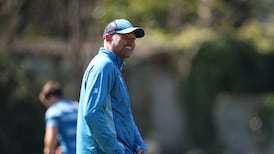This moment in time will not define the sporting life of Jordan Larmour. He’s 22. Seven starts for his country, five tries, three in one game and a back catalogue of dazzling runs, including a phenomenal score at Thomond Park in January 2018 that should partly define him.
The no-look pass intercepted by Japan’s Kenki Fukuoka is carved in stone but it can become a footnote in a great career. Undoubtedly these last days of the Schmidt empire will leave a lasting imprint on his memory, and on the player he promises to become, but it should not define him. It must not define him.
What we witnessed on Thursday just before Larmour spoke to a print huddle ahead of his return to the 15 jersey against Samoa seemed at best weird, at worst plain wrong.
A peek behind the curtain is rare, but there was Schmidt – seconds after his own press briefing – relaying instructions to young Irish players about to enter a treacherous battlefield against men with untoned bodies bulging over unwashed T-shirts, armed with ferocious looking dictaphones. Schmidt held Larmour longer than the others. He was coaching him in a hotel lobby. Preparing the prodigious athlete for the next moment, the next psychological war-zone with nobody but himself.
Rugby World Cup: Typhoon contingency plan was to move matches 18 kilometres away
Rugby World Cup: There’s no avoiding the All Blacks but the later the better
Matt Williams: Rugby falls foul of poor lawmaking, to the delight of jealous hordes
Rugby and recovery - Kamaishi welcomes the world on a wave of emotion
It seemed completely unnecessary.
Did we mention Larmour is 22? Did we mention the Thomond Park try or that stunning hat-trick in Soldier Field?
This was PlayStation rugby. The same realm where Cheslin Kolbe and Semi Radradra currently exist.
“Obviously we’ve got game plans going into games,” said Larmour immediately after being counselled by Schmidt. “We stick to them. We’ve licence, if something is on, you can take it. We don’t want to be playing PlayStation rugby.”
Why the hell not?
Here’s a free bird currently caged by the Irish system and a departing coach’s overwhelming authority. Rugby by Schmidt numbers used to work – maybe it will again – but perhaps the greatest tutor he’ll ever encounter, a masterful scribbler of attacking moves, has become an overbearing coach.
Then again, what do we know about the preparation of elite athletes?
Personality
But the young players seem petrified to show even a glimpse of their actual personality in a public forum. Elders like Rob Kearney and Rory Best are untouched by this. Schmidt colleagues have spoken privately about how he prepares for media interactions on a similar level to how he prepares for the opposition.
Larmour was not facing the enemy. He was facing people who knew his family background, who had tracked his wondrous rise while dancing between hockey and rugby at St Andrews before bursting on the professional scene as a teenager.
Considering the circumstances, he spoke well.
Gordon D’Arcy won’t say it out loud but everyone around his Clongowes team of 1997 and 1998 sees streaks of The Irish Times columnist in Larmour. The soaring rise to international rugby has been equally spectacular but, like English football learned from Gascoigne to Rooney, Leinster were ready to carefully nurture such rare talent.
“There’s an obvious difference between a Clongowes fullback straight from school in 1998 to Jordan Larmour in 2018,” wrote D’Arcy last year. “He can catch and kick, I couldn’t.”
Larmour is established without being trusted to start so long as Kearney, Keith Earls and Jacob Stockdale are fit but that collective is rarely available anymore. Schmidt attempted to remould Robbie Henshaw as a fullback against England in February. Another once in a generation player – in a squad full of them – appeared to be running in quick sand.
Kearney remains the blueprint for defensive back field play, and, age 33, he has improved his distribution skills.
“He’s one of the best in the world at grass-field cover so getting to play with him and train with him is pretty cool, and you can learn a lot from him,” said Larmour.
Kearney will return for the quarter-final so Larmour gets a chance and Ireland need his brilliance to shine through. As the slip-sliding creation of Garry Ringrose’s try against Russia proved, there is life as a centre in him yet.
“We haven’t seen enough of Jordan to know whether he’s a natural fullback, wing or centre,” D’Arcy added. “Only time and good fortune will inform us. Maybe he can do something really special like Adam Ashley-Cooper; a player that will cause the same damage no matter the position.”
Springbok flyer
Maybe he can be mentioned in the same breath as Radradra and Kolbe before October is spent. We ask about the stunning Fijian wingers. He mentions nobody by name so we insert the Springbok flyer into his mouth.
“His feet have been ridiculous, especially against New Zealand. He was doing some pretty incredible stuff,” said Larmour. “I played against him twice last year so that was pretty cool. I think he went under Scott Fardy’s legs at the RDS if you remember that one. There has been a lot of rugby played and brilliant individuals. It’s been fun watching it.”
The Chicago hat-trick 11 months ago is the last time Larmour was living it.
Remember?
“I suppose in every game you’re playing, you’re scanning early, you’re seeing what’s in front of you, and you’re seeing where the opportunity is, and you’re going for it.”
Leave him be. The Scotland performance proved his solidity at full back. PlayStation rugby is the order against Samoa. This is a World Cup. The stage where stars are supposed to shine.
And Larmour is a star.
















